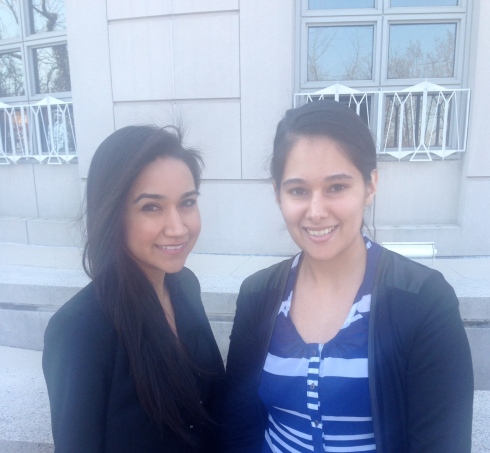This post was written by Sydney Barron, a law student at George Washington University Law School and a member of the school’s Immigration Clinic, under the direction of Professor Alberto Benitez. Benach Ragland periodically offers this space to law students and non-profit organizations to discuss their immigration cases. If you are a law school professor or a non-profit organization that wishes to tell the story of one of your immigration cases, please write us at acbenach@benachragland.com.
On March 11, 2014, my client, Julia[1] won the asylum that she requested over a decade ago. Julia fled horrific domestic violence in her home country, Guatemala, and came to the United States in 2002. Unfortunately, Julia was not able to bring her children with her when she fled. After she entered the United States, the George Washington Immigration Clinic helped her file her asylum claim. Julia had to live with uncertainty for over a decade as her case wound its way through the immigration system. By the time Julia was finally granted asylum twelve years after fleeing her abuser, she had appeared before three different immigration judges, and worked with twenty different student-attorneys from the GW Immigration Clinic.

GWU Law Student Sydney Barron
Julia filed for asylum in 2003. There was insufficient time for all of her testimony and cross-examination at her first individual merits hearing in 2004, so she had an additional individual merits hearing scheduled. The next hearing was not held until 2006 because the immigration court was so busy at the time.
When Julia first filed for asylum, the law of asylum for victims of domestic violence was far from favorable. At that time, the immigration courts were waiting for regulatory guidance on the issue of granting asylum to victims of domestic violence, but were hesitant to grant asylum while such guidance remained pending. For this reason, the immigration judge administratively closed Julia‘s case in 2006. This situation provided only temporary protection, and her case could be reopened at any time. Additionally, even though Julia could remain in the United States while her case was administratively closed, she could not bring her children here unless she was granted asylum.
A year later in 2007, the Department of Homeland Security (“DHS”) requested that the case be reopened. In June 2009, the immigration judge issued a written decision finding that Julia was credible and had suffered harm rising to the level of past persecution, but there was no “nexus” between the harm she suffered and her membership in a particular social group. The immigration judge therefore denied Julia‘s asylum claim.
The GW Immigration Clinic assisted Julia in appealing her case to the Board of Immigration Appeals (“BIA”). Before Julia‘s appeal was decided by the BIA, the law on asylum for victims of domestic violence shifted and became more favorable. The most well-known case on the eligibility of victims of domestic violence for asylum is Matter of R-A-. In Matter of R-A-, a Guatemalan woman suffered terrible abuse from her husband.[2] Fourteen years after R-A- applied for asylum, in December 2009, an immigration judge granted R-A-’s request for asylum.[3] Another central case regarding asylum for victims of domestic violence, Matter of L-R–, ended in 2010 with a grant of asylum.[4] In both Matter of R-A- and Matter of L-R-, DHS submitted briefs describing the circumstances that they considered sufficient for a domestic violence victim to be eligible for asylum.[5] Given these two historic asylum grants, a prior student-attorney at the GW Immigration Clinic submitted a Motion to Remand Julia‘s case with the BIA.
When I first met Julia, she had not yet heard back from the BIA about the Motion to Remand. During my first semester in the GW Immigration Clinic, the BIA remanded Julia’s case to the Arlington Immigration Court. My first appearance in immigration court was for Julia‘s master calendar hearing. The GW Immigration Clinic Director, Professor Alberto Benitez, and my other supervisor, Mr. Jonathan Bialosky, prepared me to ask for a grant of asylum at this hearing. They explained that this was an unlikely outcome, and was extremely unlikely without DHS’s support. However, if I were able to convince DHS to agree to a grant, the immigration judge might grant Julia asylum given the prior immigration judge’s findings on credibility and the violence Julia suffered.
On the day of the master calendar hearing, the DHS trial attorney had not yet received Julia‘s file from the BIA, and could not support a grant. Luckily, the immigration judge recognized that Julia had already been waiting for over a decade, and scheduled the merits hearing for March 11, 2014. This was a huge relief to Julia, and myself, since some cases are scheduled up to two years from the master calendar hearing date.
In preparation for the individual hearing, I met with Julia multiple times a week. Her family members had alerted her to continued threats made by her abuser, including threats to beat, rape, and kill her. I submitted affidavits from Julia and her family about these threats. I also submitted evidence from a psychiatrist, which supported Julia‘s testimony, and multiple articles about Guatemala and its institutionalized acceptance of domestic violence.
Before the individual merits hearing with the immigration judge, the GW Immigration Clinic held a moot hearing with Julia. Professor Benitez and Mr. Bialosky explained that I should not have a set of questions written down, because they had seen student-attorneys become dependent on a list of questions, ignoring what their client was actually saying. I wrote out the main issues that I wanted to get Julia to testify about, and practiced asking non-leading questions with other student-attorneys. On the day of the moot hearing, I realized the difficulty of an actual direct examination, especially the difficulty of asking non-leading questions to get Julia to provide necessary details. Additionally, Professor Benitez and Mr. Bialosky asked the student-attorney playing the role of the trial attorney to try to surprise and rattle me by objecting to my evidence and submitting new evidence during the moot. The moot hearing taught me the importance of carefully listening to the client’s testimony and asking sufficient follow-up questions to ensure the client mentions all relevant details. It also taught me the importance of projecting confidence in my questions and responses, especially when unexpected issues arise.
The day before the hearing, I called the trial attorney who was assigned to Julia‘s case. I left her a message asking if she had received my pre-trial filing, and offering to answer any questions she might have. That afternoon the trial attorney returned my call while I was in class, and while I was able to excuse myself to an empty room, I did not have any of my notes with me. My lack of notes initially worried me; however, once the trial attorney started asking me questions about the case, I realized that the months of preparation had hammered all of the facts into my head, and I could easily discuss the case without any notes. We discussed the procedural history of the case and the evidence that Julia’s abuser continued to threaten her. After answering all of the trial attorney’s questions, I felt confident that the trial attorney appreciated the grave danger that Julia would face if she were forced to return to Guatemala.
On the day of Julia’s individual merits hearing, Professor Benitez, Mr. Bialosky, and many of the other student-attorneys who came to support Julia were present in the courtroom. Immediately before the hearing, the trial attorney informed me that she would not be opposing a grant of asylum. Julia was extremely excited, but I explained that nothing was certain until the immigration judge granted her asylum. The immigration judge requested that I do a short direct examination of Julia, and after my direct examination the trial attorney did a short cross-examination. After Julia returned to her seat, the immigration judge gave his oral decision granting Julia asylum. To the surprise of everyone in the courtroom, Julia asked the judge if she could hug him. The judge explained that he could not hug her in person, but that he would “hug” her from where he was. Both Julia and the immigration judge hugged the air in front of them in a very touching moment. Julia also hugged the trial attorney after the hearing was over. Professor Benitez told me later that it was the first time that he had ever seen a client ask to hug the immigration judge or the trial attorney.
I am grateful to the GW Immigration Clinic for the opportunity to assist Julia in her search for safety. I am grateful to my supervisors, Professor Benitez and Mr. Bialosky, who guided me through the process, set up moot hearings, and provided feedback on my pre-trial filing and hearing preparation. I am grateful to all of the other student-attorneys for their help throughout the year, providing feedback and helping to prepare Julia for cross-examination. Finally, I am grateful to Julia, an inspiring woman who persevered with immense strength. The opportunity to help protect her from further abuse and finally bring her a sense of peace and closure was an amazing gift.
[1] My client’s name has been changed to protect her identity.
[2] Matter of R-A-, 22 I&N Dec. 906 (BIA 1999), vacated, 22 I&N Dec. 906 (A.G. 2001), remanded, 23 I&N Dec. 694 (A.G. 2005), remanded, 24 I&N Dec. 629 (A.G. 2008).
[3] Lisa Mendel-Hirsa, Recent Landmark Victories in the On-Going Struggle for U.S. Immigration Law to Recognize and Fully Protect Women’s Human Rights, Empire Justice Center (Nov. 19, 2010), http://www.empirejustice.org/issue-areas/domestic-violence/battered-immigrants/articles/domestic-violence-and.html#.U0Ac3fldVHI.
[4] Id.
[5] Department of Homeland Security’s Position on Respondent’s Eligibility for Relief,
Matter of R-A-, 22 I. & N. Dec. 906 (Feb. 19, 2004) (File No. A 73 753 922); Department of Homeland Security’s Supplemental Brief, Matter of [L-R-, redacted] (Apr. 13, 2009).
Tags: Domestic violence, gender based asylum, George Washington, guatemala, GW Law, immigration court, matter of l-r-, matter of r-a-
 ficer to beg for protection. Instead of help, these refugees were among the first to be detained at the Federal Law Enforcement Training Center in Artesia, New Mexico, a makeshift detention facility in the middle of the desert, hidden out of sight and out of mind as the Obama Administration sanctioned a series of procedures meant to deport them as quickly as possible right back to the danger from which they had fled. But the arrival of the American Immigration Lawyers Association’s pro bono project halted the deportation of Kira, Ricky, and the hundreds of other mothers and children detained in Artesia. Benach Ragland Partner Dree Collopy spent a week volunteering in Artesia to provide pro bono legal services to women and children. While there, she met Kira and Ricky and was inspired by their courage and strength. She took their case pro bono, demanding compliance with U.S. and international law and due process on their behalf.
ficer to beg for protection. Instead of help, these refugees were among the first to be detained at the Federal Law Enforcement Training Center in Artesia, New Mexico, a makeshift detention facility in the middle of the desert, hidden out of sight and out of mind as the Obama Administration sanctioned a series of procedures meant to deport them as quickly as possible right back to the danger from which they had fled. But the arrival of the American Immigration Lawyers Association’s pro bono project halted the deportation of Kira, Ricky, and the hundreds of other mothers and children detained in Artesia. Benach Ragland Partner Dree Collopy spent a week volunteering in Artesia to provide pro bono legal services to women and children. While there, she met Kira and Ricky and was inspired by their courage and strength. She took their case pro bono, demanding compliance with U.S. and international law and due process on their behalf.



















